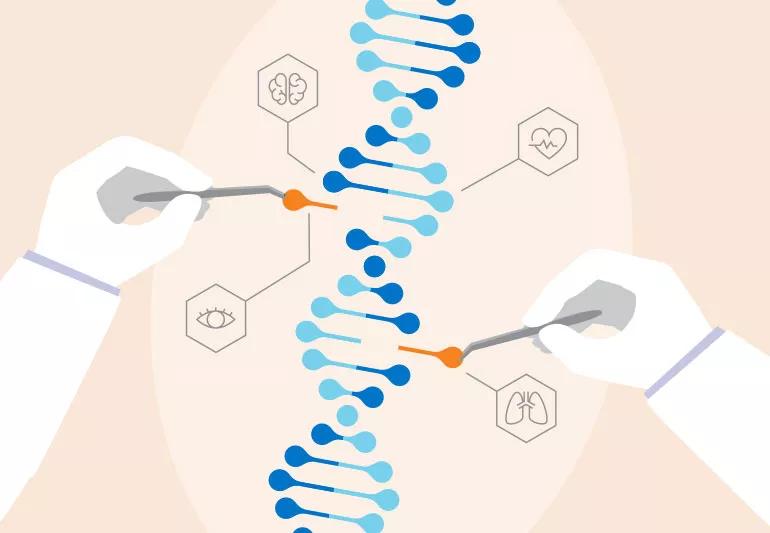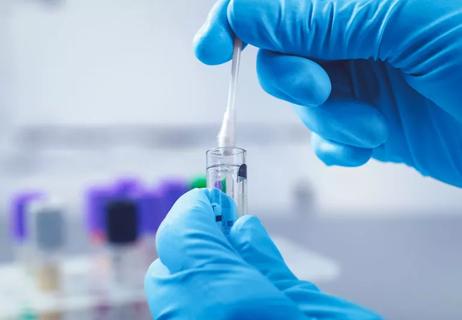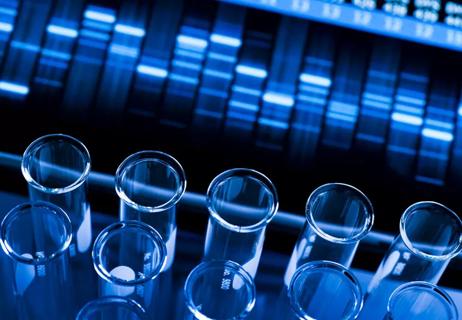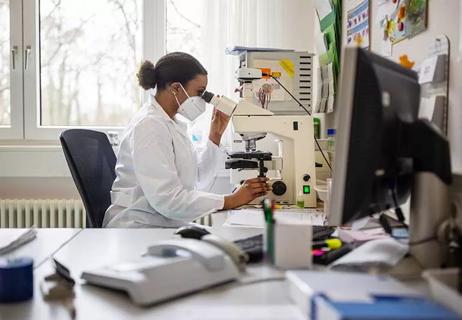This evolving technology may one day eliminate conditions like sickle cell anemia and hemophilia

In 2013, two biochemists published a paper proclaiming they’d discovered a potentially game-changing method of manipulating genes. CRISPR — which sounds like a veggie-forward gastro pub — won them each a Nobel Prize.
Advertisement
Cleveland Clinic is a non-profit academic medical center. Advertising on our site helps support our mission. We do not endorse non-Cleveland Clinic products or services. Policy
In the years since, CRISPR (or Clustered Regularly Interspaced Short Palindromic Repeats) has lived up to the hype. It’s altered the global scientific landscape and raised questions about what kinds of revolutionary changes scientists and healthcare providers could — and should — pursue.
What if we could make foods allergy-free and crops drought-resistant? What if we could eliminate invasive species and protect against infectious diseases like malaria? What if we could revive extinct species? What if we could remove or repair mutations that cause inherited conditions? Or create custom immunotherapies to treat an individual’s cancer?
The prospects are that exciting.
If your understanding of genetics starts and ends with high school biology — or the (very fictional) Jurassic Park movies — you’re not alone. This stuff is complicated. That’s why we asked genomics and immunotherapy expert Timothy Chan, MD, PhD, to break CRISPR down for us, so we can better understand why, over a decade later, it’s still got researchers so excited.
Before we jump into CRISPR, let’s start with the concept of gene editing.
Gene editing is the process of altering genetic material (DNA). That could mean changing a few individual genes or an entire sequence. Research has been ongoing for more than a decade that’s looking at using gene editing on mutations that cause serious health conditions in people. The goal of this gene editing research is to eliminate or correct the mutation that’s causing the health condition, or has the potential to cause one, such as certain cancers. In other research studies, gene editing is being explored so a mutation isn’t passed down to children at birth.
Advertisement
For example, the U.S. Food and Drug Administration (FDA) approved a gene therapy in late 2022 that introduces a gene needed for blood clotting into people with hemophilia B. It’s one of several cellular and gene therapy products currently in use today.
There are many different techniques and applications for gene editing. CRISPR is one approach to gene editing that’s showing promise in ongoing clinical trials.
Now that we’re clear on what gene editing is, let’s focus on a specific approach: CRISPR.
Clustered Regularly Interspaced Short Palindromic Repeats, otherwise known as CRISPR, “was originally identified in bacteria, as a bacterial defense system,” says Dr. Chan.
That’s right. Bacteria have immune systems, too.
CRISPR contains “spacers” — sequences of DNA left over from unfriendly viruses or other entities — as well as repeating sections of genetic material. Those sequences provide acquired immunity, and form the building blocks of the gene editing system or process. It creates a sort of blueprint that allows enzymes in genetic material to make changes to sequences of DNA in living cells. One of the best-known enzymes used for this purpose is called Cas9, which is why you’ll sometimes hear people talk about CRISPR-Cas9.
“Over the years, people have discovered that specific enzymes that allow CRISPR to work — Cas9 is one of them. But there are other ones, and they can be tailored to target sequences of interest in the DNA for specific cuts to be made,” Dr. Chan explains.
You can think of the underlying mechanism of CRISPR gene editing as being similar to the way magnetic shapes are drawn to each other or the way Lego blocks fit together.
The segments in CRISPR are transcribed into RNA. This RNA includes a guide sequence, which is a match to existing DNA in a person’s body.
“That guide sequence can be tailored to whatever you want,” Dr. Chan says. “And as a result, you can make specific alterations or mutations in a part of the genome that you are targeting with a high degree of accuracy.”
Along for the ride with this guide sequence is an enzyme like Cas9.
When the guide sequence and enzyme find the desired DNA to edit, the enzyme can then get down to business. It attaches itself to this DNA and makes changes, whether that’s a cut or alteration.
CRISPR technology has come a long way, Dr. Chan says. “The first generation of CRISPR was a great way to inactivate genes. It only made a break in genes. Then, the DNA would get filled up with natural repair enzymes.”
Advertisement
But new versions of CRISPR — like CRISPR prime or CRISPR HD — are more advanced.
“These can allow actual replacements to occur,” Dr. Chan continues. “You can even very accurately replace one sequence — one of the letters in the genome — with another letter. And you can make specific mutations.”
CRISPR’s ability to make very specific, very small cuts has the potential to transform how healthcare providers can address certain genetic diseases.
Dr. Chan is optimistic about the future of CRISPR based on the success of ongoing clinical trials in human subjects. “For any type of genetic diseases caused by a single mutated gene, you can use CRISPR to mutate it and make it normal. That’s why it’s useful. It’s a way for us to change errors in the genome.”
“Right now, CRISPR is geared toward correcting a single change in genes,” he adds. “While combinations may be possible in the future, we’re just not there yet.”
While gene editing is already in use, CRISPR is still in the clinical trials phase, Dr. Chan says. “It’s used all the time in research laboratories and industries,” he notes. “Many clinical trials are testing CRISPR in the setting of genetic diseases and cancer.”
Interestingly, CRISPR can be used to detect certain diseases. The best-known example is the Sherlock CRISPR SARS-CoV-2 Kit: A COVID-19 test that received emergency use authorization (EAU) from the FDA in 2020.
Advertisement
“But there’s no FDA-approved CRISPR therapy right now. The clinical trials are ongoing,” he says.
These include trials looking at CRISPR to correct genetic diseases such as cystic fibrosis, Huntington’s disease and muscular dystrophy.
Dr. Chan adds that there are also major clinical trials in process for blood disorders, where CRISPR is being used to correct the gene alteration that causes the condition. As one example, he cites a promising trial looking at CRISPR-Cas9 gene editing for sickle cell disease and β-thalassemia, written about in an early 2021 issue of the New England Journal of Medicine. β-thalassemia is an inherited blood disorder that impacts the body’s ability to create hemoglobin — an iron-dense protein that serves as the primary ingredient in red blood cells.
There are also clinical trials looking to see if CRISPR can be used to treat certain cancers. Dr. Chan notes that chimeric antigen receptor (CAR) T-cell therapy is one of the first gene therapies approved for leukemias. Current research is looking at whether CRISPR technology can make this treatment even more effective.
“In CAR T-cell therapy, you take out T-cells from someone and put in a receptor — a new way for these cells to target something on cancer cells — and then put these cells back in the patient,” he explains. “Researchers are running trials now where they use CRISPR to alter those T-cells to make them even more active.”
Advertisement
CRISPR therapies can take on many different forms. CRISPR has been inserted directly into the body before. It was famously injected into the eyes of seven people with a rare hereditary blindness disorder in 2020, two of whom later told NPR that they regained some ability to see colors. There are human trials in process right now that deliver CRISPR through gels and creams, through food or drink, skin grafts or injections. Ex-vivo delivery is also common: That’s when CRISPR is used to modify a cell outside the body. The cells are then re-inserted into the body using a harmless virus.
The results have been promising so far. “I do believe in the next three to five years — possibly even sooner — we’re going to see approval to treat some diseases,” Dr. Chan states.
With any type of CRISPR therapy, Dr. Chan says there’s a risk of getting “off-target effects” or unexpected side effects.
“Whenever you’re altering something as fundamental as DNA, you just don’t know what might happen” he explains. “There’s always a chance for the unexpected. You can potentially have effects on your DNA that were not intended.”
At the moment, he doesn’t have any specific examples of what these effects might be — and he notes that existing research suggests the risk is pretty low. Still, data from future research might tell a different story.
Dr. Chan nevertheless sees “a lot of potential” for CRISPR in the coming years.
“The field is moving very quickly,” he says. “We’re seeing continual improvement of the actual CRISPR tools being used.
“It’s getting more accurate and more flexible in terms of what you can do. There are various engineered modified variants of CRISPR now that are allowing very specific, very accurate changes with fewer off-target effects. So, I think the future is very bright.”
Learn more about our editorial process.
Advertisement

Genetic markers can determine if you’ll develop Huntington’s disease or pass it on to your children

Why both nature and nurture matter

The short answer from a genetic counselor

Testing can both reveal the likelihood that you’ll pass on complement 3 glomerulopathy and identify possible treatments

The OR6A2 gene could be behind your dislike of this herb — but with time, your brain may be convinced to like it

Having a first-degree biological relative with this eye condition raises your risk, but other factors are at play, too

Babies can get congested easily, but you can calm their cough by keeping them hydrated, using nasal drops and running a humidifier

Weight loss may cause loose, sagging skin and muscle loss to your rear

Several conditions, like vitiligo and fungal infection, can cause a loss of pigmentation, leading to white spots or patches on your skin